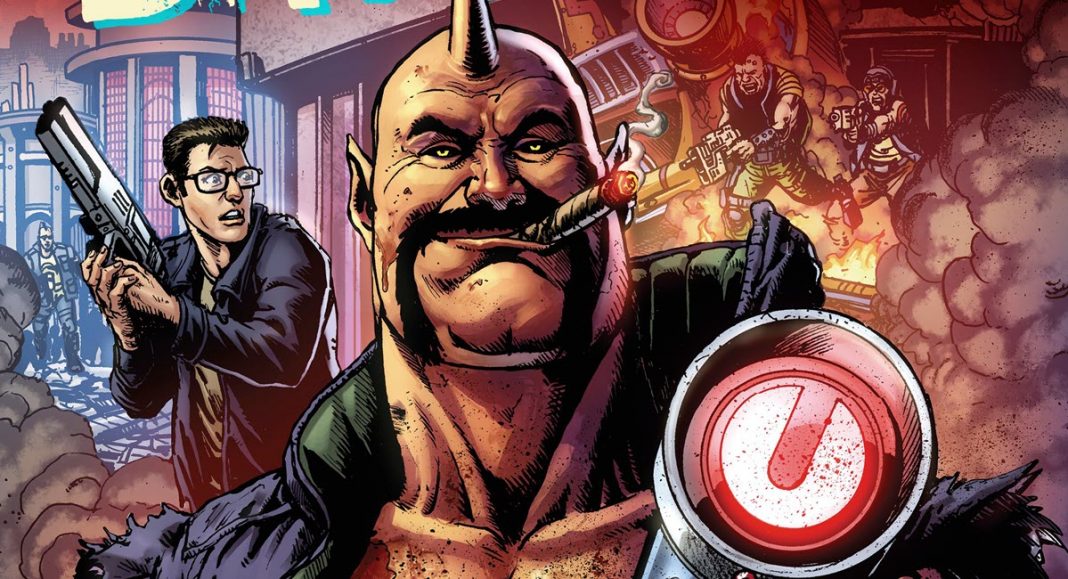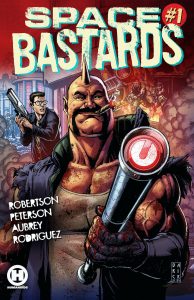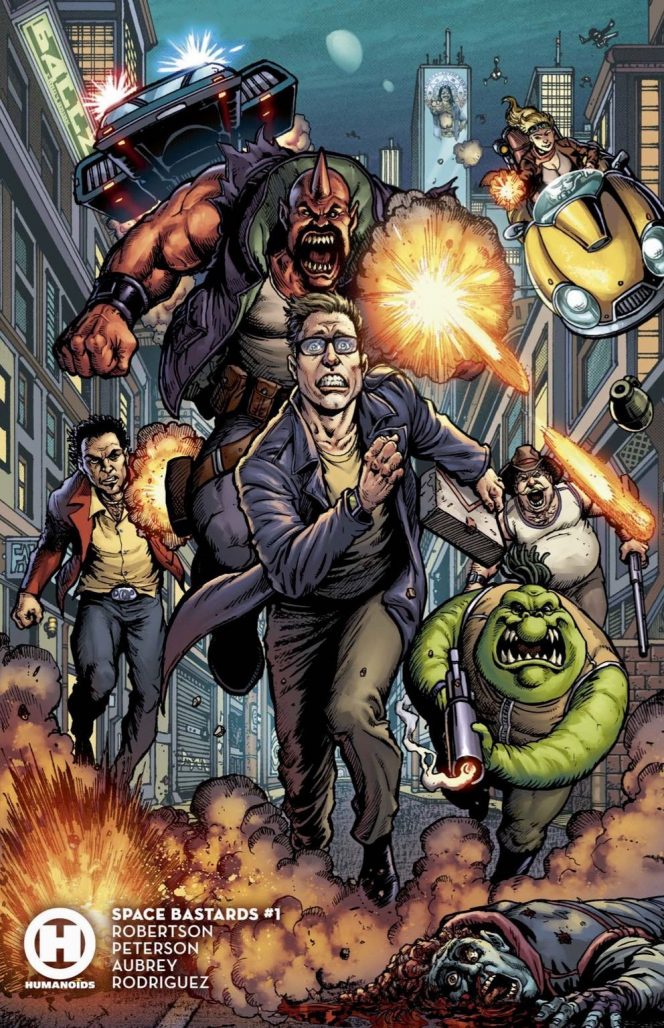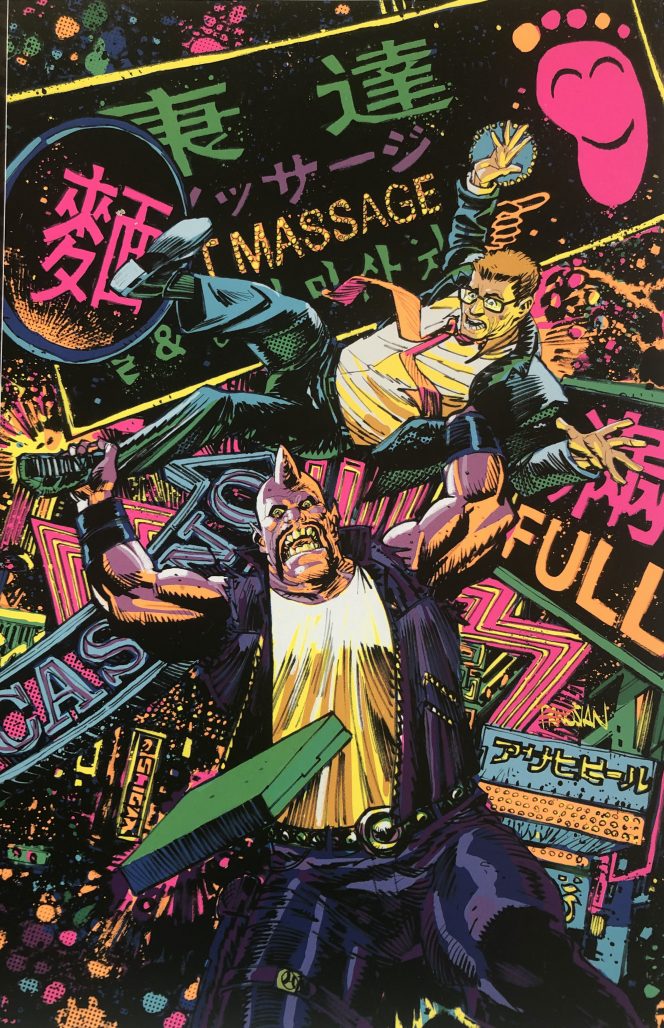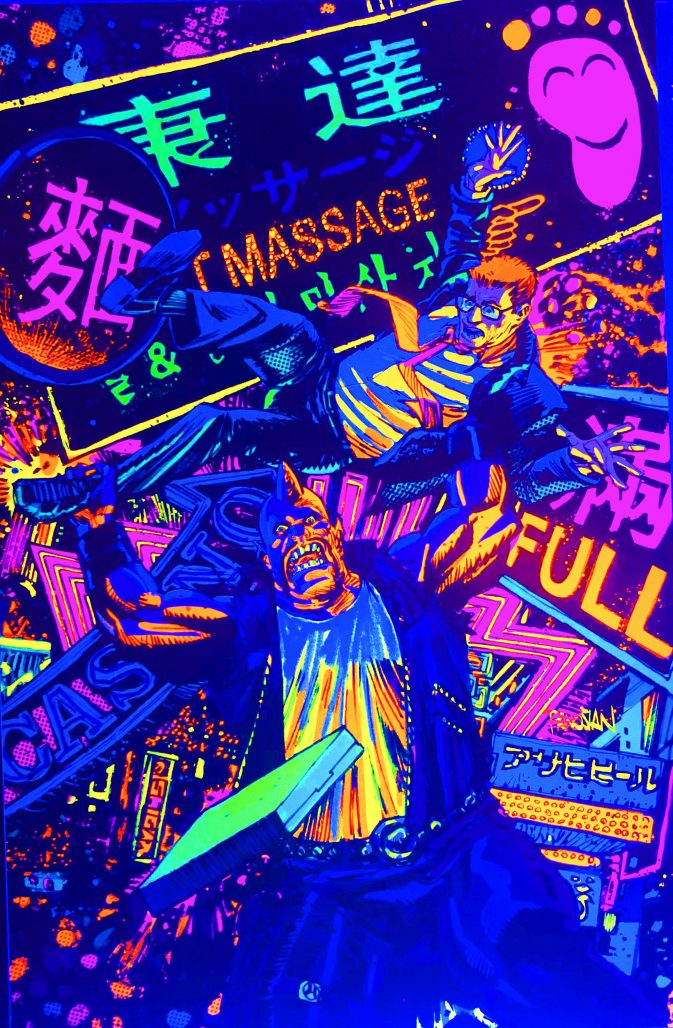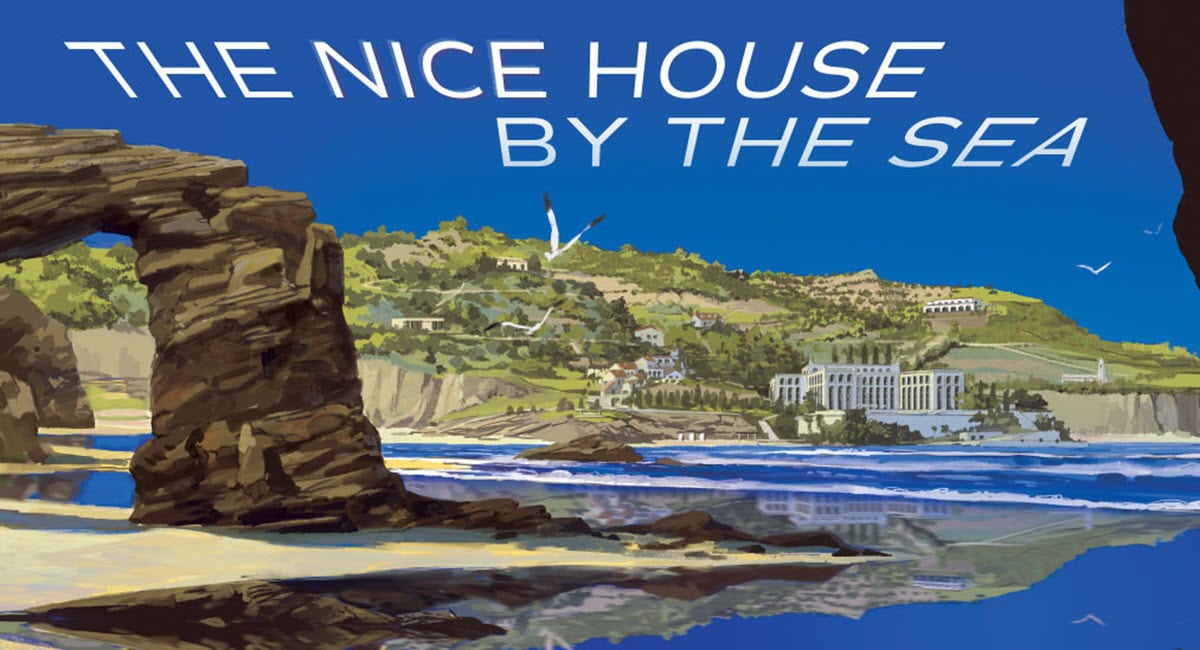Space Bastards is a new sci-fi action series coming from Humanoids early next year. Co-created by artist Darick Robertson and writers Eric Peterson & Joe Aubrey, the first arc of the series is illustrated by Robertson, with color art by Diego Rodriguez. The series follows David S. Proton, a down-on-his-luck accountant who joins the Intergalactic Postal Service looking to make some cash. Paired with Manny Corns, a physically-imposing mail carrier who calls himself “The Manicorn,” David soon learns that the world of mail delivery is unexpectedly cut-throat — literally — as freelance delivery people maim and kill each other over packages and large paydays.
Originally produced via a successful Kickstarter campaign, Space Bastards also features the work of artists like Simon Bisley, Clint Langley, and Dan Panosian. Not bad for a project dreamed up by a 13-year-old. The Beat chatted with Peterson and Aubrey about the long genesis of Space Bastards, how the project has evolved from the Kickstarter to its Humanoids iteration, and the relevance of a story about interstellar postal workers.
Joe Grunenwald: The Kickstarter for the first volume of Space Bastards mentions that this is an idea one of you has had since you were 13. Which of you maniacs came up with this, and what is it about the concept that’s made it stick with you for so long?
Joe Aubrey: Eric came up with the original idea – a guy, in over his head, delivering packages for the Intergalactic Postal Service in a ridiculously hostile universe.
Eric Peterson: As a kid of the ’80s and ’90s I just really wanted to make more stories about scoundrels in space. Han Solos. I wanted to see more of that side of the fiction I grew up with.
Grunenwald: How much has that initial idea evolved over the years, particularly once the two of you decided to pursue it together?
Peterson: Things evolved when we got together and started thinking about what would make someone take on such a dangerous job and how to make it even more dangerous. The Space Bastards universe is a mess – unemployment is sky high, the economy is tanking, and basic services are unreliable. Postal carriers are encouraged to intercept, kill, and steal from each other to complete deliveries. The courier that actually delivers the package gets paid – the rest get nothing.
Aubrey: The other big change was shifting focus to an ensemble cast of bastards. Having a full roster of characters with different backgrounds and different reasons for working for the postal service has really helped us tell a bigger story.
Grunenwald: Have you made any changes to Space Bastards between when the Kickstarter version of the book was completed and now? Is there anything you would change if you could?
Aubrey: One huge development for the project as a whole was forging a partnership with Humanoids shortly after the first Kickstarter. They have been amazingly supportive and helpful. We’ve learned a lot from them and even more from mistakes we’ve made. Can’t say I’d change anything though.
Peterson: We’ve made no significant changes to the overall story or tone. We’ve got even more material completed than 18 months ago.
Grunenwald: Space Bastards was originally a graphic novel and is now being presented as a seven-issue series. How did you approach breaking it up into satisfying issue-length pieces?
Peterson: We actually originally wrote these as serialized single issues. Each individual issue will present a complete story but all are part of a greater whole. The individual issues will be released through Humanoids in a unique reading order for fans who like reading every month.
Simultaneously, the hardcovers are our “director’s cut” version. It’s a completely different presentation. If you read it monthly as singular issues you experience it one way, and if you binge-read the hardcovers you get a totally different experience.
Grunenwald: You’ve worked with a murderer’s row of fantastic artists on this book, from Darick Robertson to Simon Bisley to Clint Langley. What does each of them bring to the story?
Peterson: Hands down it’s my favorite thing about the process. Each artist is chosen not only because we want to work with them, but because we think they’d be perfect for that particular corner of the universe– that story. We try to really lean into each artist’s unique advantages and style, and then write the scripts for that. If I’m working on a Bisley story for example, I’ll read nothing but Simon’s works for like a month so that I’m stuck in his visual language before we write that script.
Aubrey: It would take too long to explain specifically what each artist has brought to the story, but they have all contributed immeasurably. Particularly Darick, who co-created this whole thing and really established the visual identity of the Space Bastards Universe. Each artist has caused me to think differently about certain characters and even the project as a whole. We are extremely lucky to have worked with all of them.
Grunenwald: You’ve also got a one-in-ten blacklight variant cover on the first issue by Dan Panosian. Why go with that blacklight effect?
Peterson: That actually was the brainchild of our publisher, Mark Waid. That feels weird for me to say, by the way. The guy I grew up reading great Justice League stories from is our publisher and championed this amazing variant cover for Space Bastards. I never imagined I’d get to say that.
Grunenwald: Postal workers in the U.S. have always gotten a bit of a bad rap, but in the past year the Postal service has, thanks to the pandemic and the election, become a political lightning rod. How do you think Space Bastards is relevant to what’s going on in the world now, if at all?
Aubrey: Our main goal is to thrill our readers with over-the-top violence, humor, and gorgeous artwork. However, in Space Bastards, the postal service has evolved into a lucrative, but extremely dangerous version of Uber or Postmates. So gig economy capitalism and all the ridiculousness that comes with it are part of the presentation. That’s relevant, I suppose, because nearly half of the US workforce are gig workers and capitalism itself has been more or less on trial during the pandemic this year.
Peterson: Most of the characters are working for the Postal service because they have suffered some type of personal tragedy or inherent societal disadvantage. Pretty relatable these days.
Grunenwald: Are you still planning a Kickstarter for Space Bastards volume 2?
Aubrey: Yes. Volume 2 hits Kickstarter on January 11th. We will also have freshly printed copies of Volume 1 for sale at www.spacebastards.com.
Grunenwald: What would you say to people who are on the fence about picking up Space Bastards?
Peterson: Issue 1, handsomely published by Humanoids, comes out January 13th in comic stores. Grabbing one of those is a wonderful way to see if it is for you. If you are a fan of Darick Robertson, Simon Bisley, 2000AD, or any of our artists – you will not regret buying any version of this book. Check out www.spacebastards.com for reviews, sample pages, and more information.
Handsomely published by Humanoids, Space Bastards #1 arrives in comic shops on January 13th, 2021, and is available for pre-order through Monday, December 14th.


